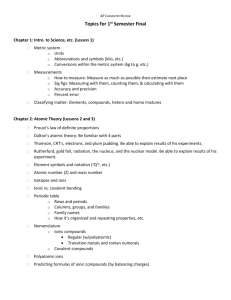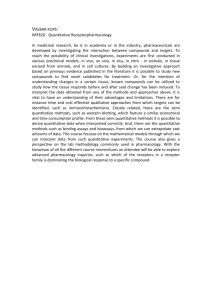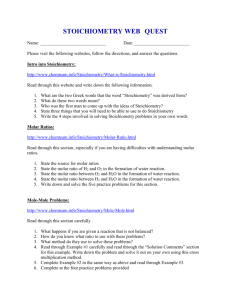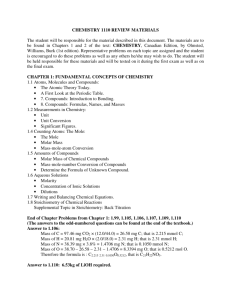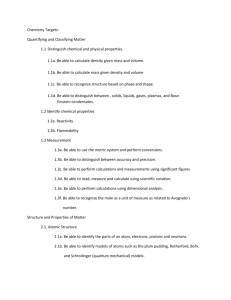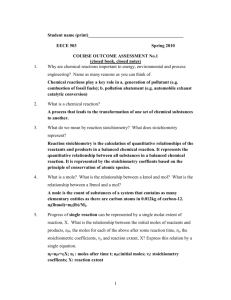Chemistry Standards and Pacing Guide
advertisement
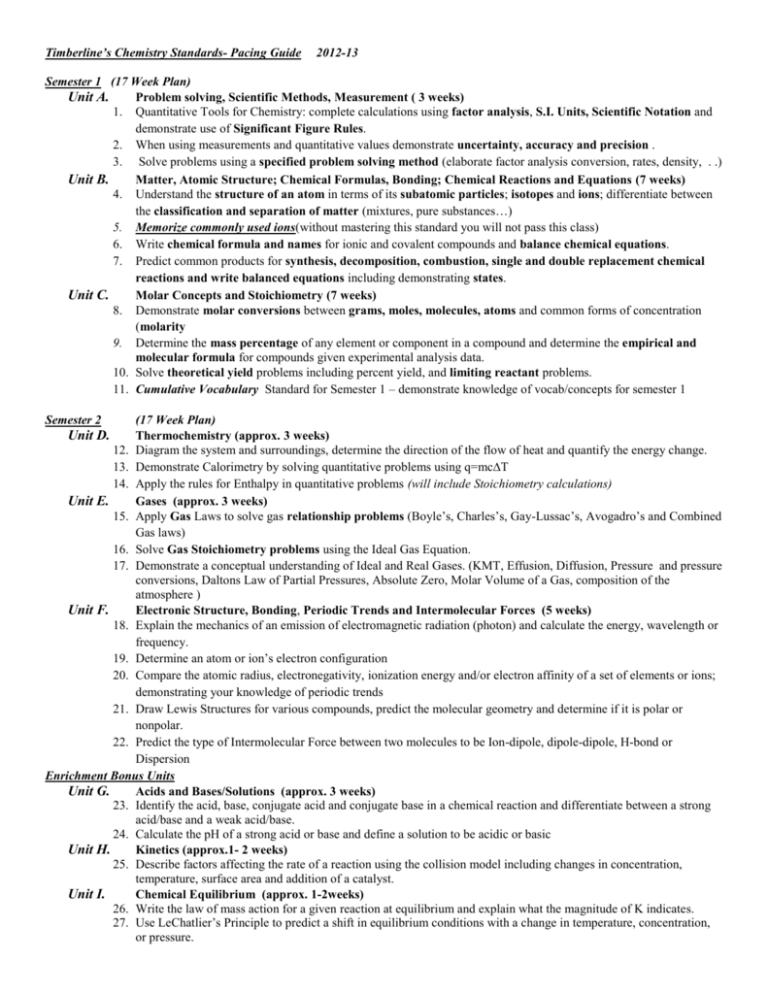
Timberline’s Chemistry Standards- Pacing Guide 2012-13 Semester 1 (17 Week Plan) Unit A. Problem solving, Scientific Methods, Measurement ( 3 weeks) 1. Quantitative Tools for Chemistry: complete calculations using factor analysis, S.I. Units, Scientific Notation and demonstrate use of Significant Figure Rules. 2. When using measurements and quantitative values demonstrate uncertainty, accuracy and precision . 3. Solve problems using a specified problem solving method (elaborate factor analysis conversion, rates, density, . .) Unit B. Matter, Atomic Structure; Chemical Formulas, Bonding; Chemical Reactions and Equations (7 weeks) 4. Understand the structure of an atom in terms of its subatomic particles; isotopes and ions; differentiate between the classification and separation of matter (mixtures, pure substances…) 5. Memorize commonly used ions(without mastering this standard you will not pass this class) 6. Write chemical formula and names for ionic and covalent compounds and balance chemical equations. 7. Predict common products for synthesis, decomposition, combustion, single and double replacement chemical reactions and write balanced equations including demonstrating states. Unit C. Molar Concepts and Stoichiometry (7 weeks) 8. Demonstrate molar conversions between grams, moles, molecules, atoms and common forms of concentration (molarity 9. Determine the mass percentage of any element or component in a compound and determine the empirical and molecular formula for compounds given experimental analysis data. 10. Solve theoretical yield problems including percent yield, and limiting reactant problems. 11. Cumulative Vocabulary Standard for Semester 1 – demonstrate knowledge of vocab/concepts for semester 1 Semester 2 (17 Week Plan) Thermochemistry (approx. 3 weeks) 12. Diagram the system and surroundings, determine the direction of the flow of heat and quantify the energy change. 13. Demonstrate Calorimetry by solving quantitative problems using q=mc∆T 14. Apply the rules for Enthalpy in quantitative problems (will include Stoichiometry calculations) Unit E. Gases (approx. 3 weeks) 15. Apply Gas Laws to solve gas relationship problems (Boyle’s, Charles’s, Gay-Lussac’s, Avogadro’s and Combined Gas laws) 16. Solve Gas Stoichiometry problems using the Ideal Gas Equation. 17. Demonstrate a conceptual understanding of Ideal and Real Gases. (KMT, Effusion, Diffusion, Pressure and pressure conversions, Daltons Law of Partial Pressures, Absolute Zero, Molar Volume of a Gas, composition of the atmosphere ) Unit F. Electronic Structure, Bonding, Periodic Trends and Intermolecular Forces (5 weeks) 18. Explain the mechanics of an emission of electromagnetic radiation (photon) and calculate the energy, wavelength or frequency. 19. Determine an atom or ion’s electron configuration 20. Compare the atomic radius, electronegativity, ionization energy and/or electron affinity of a set of elements or ions; demonstrating your knowledge of periodic trends 21. Draw Lewis Structures for various compounds, predict the molecular geometry and determine if it is polar or nonpolar. 22. Predict the type of Intermolecular Force between two molecules to be Ion-dipole, dipole-dipole, H-bond or Dispersion Enrichment Bonus Units Unit G. Acids and Bases/Solutions (approx. 3 weeks) 23. Identify the acid, base, conjugate acid and conjugate base in a chemical reaction and differentiate between a strong acid/base and a weak acid/base. 24. Calculate the pH of a strong acid or base and define a solution to be acidic or basic Unit H. Kinetics (approx.1- 2 weeks) 25. Describe factors affecting the rate of a reaction using the collision model including changes in concentration, temperature, surface area and addition of a catalyst. Unit I. Chemical Equilibrium (approx. 1-2weeks) 26. Write the law of mass action for a given reaction at equilibrium and explain what the magnitude of K indicates. 27. Use LeChatlier’s Principle to predict a shift in equilibrium conditions with a change in temperature, concentration, or pressure. Unit D.
